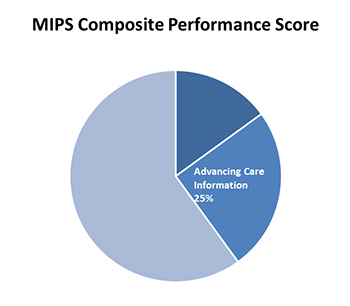Under the Merit-Based Incentive Payment System (MIPS), clinicians are required to meaningfully use certified electronic health record (EHR) technology. The EHR component of MIPS is referred to as Advancing Care Information (ACI).
Eligibility
All eligible clinicians (ECs), including physicians, nurse practitioners, physician assistants, clinical nurse specialists and certified registered nurse anesthesiologists are required to use certified EHR technology in 2018. The Centers for Medicare and Medicaid Services (CMS) has proposed expanding the category of ECs to include physical and occupational therapists, audiologists, nurse midwives, clinical social workers and nutrition professionals for 2019.
All MIPS-eligible clinicians will be able to participate as individuals, members of a group, or as part of the newly created virtual group option for 2018 reporting and beyond.
Objectives and Measures
In 2018, clinicians can utilize the following options for reporting based on the edition of certified EHR technology in use:
- ECs and groups can report ACI Transition Objectives and Measures using 2014 Edition CEHRT, 2015 Edition CEHRT or a combination of the two
- ECs and groups can report the ACI Objectives and Measures using 2015 Edition CEHRT or a combination of 2014 and 2015 Edition CEHRT
Scoring
In 2018, the ACI category accounts for 25 percent of the MIPS total score. The ACI score consists of a base score, a performance score and a possible bonus score. ECs, groups and virtual groups must report for a 90-day continuous period under the ACI category.
Base Score
To receive the base score of 50 points for the ACI category, clinicians must report data for these required measures:
- Performing a Security Risk Analysis
- E-Prescribing
- Providing Patient Access to Their Data
- Sending Summary of Care via Health Information Exchange
- Requesting/Accepting Summary of Care
In contrast to the 20 measures required under the Medicare EHR Incentive Program, if any of these measures are missed, clinicians will earn nothing for the entire ACI category of the MIPS Composite Score.
Performance Score
Eligible clinicians can earn additional points based on their performance for measures that comprise the following four objectives:
- Patient Electronic Access
- Coordination of Care Through Patient Engagement
- Health Information Exchange
- Public Health Reporting
The maximum point total for the ACI component of the MIPS Composite Score is capped at 100 points, so clinicians have some flexibility to focus on measures attributable to the performance score.
Bonus Points
An eligible clinician can earn bonus points by reporting to any single public health agency or clinical data registry, including specialized registries like the PINNACLE Registry, and an additional bonus for reporting to additional public health agencies or clinical data registries. A bonus payment is available for using certified EHR technology to complete certain activities in the Improvement Activities category, such as managing referrals and consultations. Finally, a bonus is available for using 2015 certified EHR technology. These bonus points will be added to the clinician’s ACI score after calculation of the performance score.

Additional Information
Other Health IT Requirements
In addition to the ACI component of MIPS, there are two additional requirements for clinicians and hospitals. Firstly, clinicians and hospitals must cooperate with any activities conducted by the Office of the National Coordinator for Health IT (ONC) pertaining to health IT surveillance and oversight activities regarding the performance of the certified EHR technology in use by the clinician. These surveillance and oversight activities include responding to requests for information from ONC in a timely manner and facilitating onsite review of certified EHR technology. Secondly, clinicians and hospitals are required to attest that they have not knowingly and willfully taken action to limit or restrict the compatibility or interoperability of certified EHR technology. Except for the ONC surveillance and information blocking requirements, these changes do not apply to hospitals or critical access hospitals that remain under the federal EHR Incentive Programs.
2018 Payment Adjustment
At present, clinicians who have not successfully demonstrated meaningful use through the EHR Incentive Program in a prior year and are reporting for the EHR Incentive Program the first time in 2017 will be subject to a payment adjustment in 2018.
Hardship Exemption
There are several hardship exemptions available for 2018. If a hardship exemption is granted, the 25% for the ACI category is reallocated to the quality category.
- Automatic Extreme and Uncontrollable Circumstance Policy for hurricane victims
- Significant Hardship Exemption
- Hardship Exemption for MIPS ECs in Small Practices
- Exception for Hospital-based ECs
- Exception for ECs with Decertified EHRs
- Reweighting to 0% for Ambulatory Surgical Center (ASC)-based MIPS ECs
Quick Tips to Prepare for Advancing Care Information
- Review ACC and CMS Quality Payment Program resources and participate in educational sessions.
- Determine the status of your current EHR Incentive Program participation.
- Decide if you will be implementing new EHR technology, or readying existing technology to meet the MIPS objectives and measures for ACI.
- Review the EHR Contracting Guide and the Health IT Playbook to explore the purchase or upgrade of Certified Health IT to meet the MIPS objectives and measures.
- Reach out to a vendor of Certified Health IT who can assist you in preparing your EHR system and staff for MIPS reporting.
- Evaluate if your organization is meeting the current objectives and measures using this comparison table.
Additional Resources
